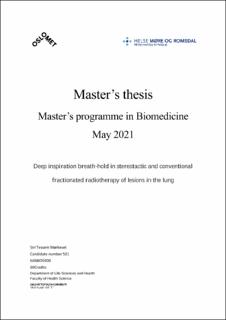Deep inspiration breath-hold in stereotactic and conventional fractionated radiotherapy of lesions in the lung
Abstract
The purpose of the clinical study was to evaluate lung cancer patients’ ability to perform deep inspiration breath-hold (DIBH) during CT simulation and throughout the treatment course of radiation therapy (RT). In addition, we evaluated target sizes, organs at risk sizes and doses to the respective volumes in volumetric modulated arc therapy RT plans in free breathing (FB) and DIBH. Twenty-one patients with a peripheral lesion in the lung where RT was prescribed were included. All patients underwent breath-hold training at CT and if they complied with the requirements, a CT in DIBH, in addition to CT and 4DCT in FB, were obtained. Treatment plans in FB and DIBH were generated, and dose parameters as well as volume sizes were compared. The endpoints for evaluation were patient compliance, target dose coverages and doses to the organs-at-risk. Nineteen out of 21 patients completed treatment in DIBH. This clinical study found high patient DIBH compliance in both CT simulation and treatment for lung cancer patients. A significant reduction was found in target sizes overall and for stereotactic body radiation therapy in DIBH, as well as significantly decreased doses to heart, chest wall and lungs. DIBH in RT of lung lesions is feasible, and a routine to manage intra-fractional deviation should be established upon implementation. Målet med denne kliniske studien var å evaluere lungekreftpasienters evne til å holde pusten i dyp innpust under CT og strålebehandling. Vi evaluerte også størrelsen på målvolumet, risikoorganers størrelse og doser til de respektive volumene i volummodulert rotasjonsstråleterapi doseplaner i fri pust og i dyp inspirasjon. Tjueen pasienter med perifere lungelesjoner ble inkludert. Alle pasienter gjennomgikk pustetrening ved CT og om de bestod kravene gjennomgikk de tre CT ’er; en CT i dyp innpust, en CT i fri pust og en firedimensjonal CT i fri pust. Doseplaner i fri pust og dyp innpust ble utformet og volumstørrelser og dosestørrelser ble sammenlignet mellom fri pust og dyp inspirasjon. Endepunktene for evalueringen var pasientenes etterlevelse, dosedekning til målvolum, og doser til risikoorganer. Nitten av 21 pasienter fullførte behandling i dyp innpust. Denne studien fant en høy etterlevelse blant pasientene både under CT og i løpet av strålebehandlingen. Studien viste signifikant reduksjon i størrelsen på målvolumene totalt og for stereotaksi i dyp innpust, samt signifikant reduksjon av dosen til hjerte, brystvegg og lunger. Strålebehandling i dyp innpust er dermed gjennomførbart for pasienter med lesjoner i lunge og en rutine for håndtering av intrafraksjonell variasjon må etableres før man implementerer denne teknikken i behandlingen av lesjoner i lunge.
